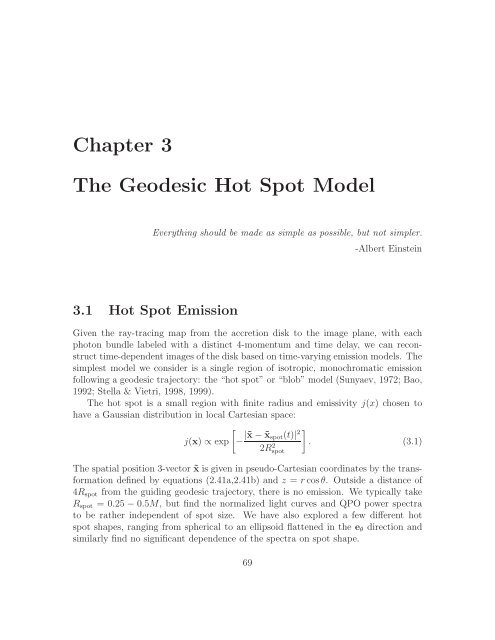Radiation Transport Around Kerr Black Holes Jeremy David ...
Radiation Transport Around Kerr Black Holes Jeremy David ...
Radiation Transport Around Kerr Black Holes Jeremy David ...
You also want an ePaper? Increase the reach of your titles
YUMPU automatically turns print PDFs into web optimized ePapers that Google loves.
Chapter 3<br />
The Geodesic Hot Spot Model<br />
Everything should be made as simple as possible, but not simpler.<br />
-Albert Einstein<br />
3.1 Hot Spot Emission<br />
Given the ray-tracing map from the accretion disk to the image plane, with each<br />
photon bundle labeled with a distinct 4-momentum and time delay, we can reconstruct<br />
time-dependent images of the disk based on time-varying emission models. The<br />
simplest model we consider is a single region of isotropic, monochromatic emission<br />
following a geodesic trajectory: the “hot spot” or “blob” model (Sunyaev, 1972; Bao,<br />
1992; Stella & Vietri, 1998, 1999).<br />
The hot spot is a small region with finite radius and emissivity j(x) chosen to<br />
have a Gaussian distribution in local Cartesian space:<br />
j(x) ∝ exp<br />
[− |˜x − ˜x ]<br />
spot(t)| 2<br />
. (3.1)<br />
2R 2 spot<br />
The spatial position 3-vector ˜x is given in pseudo-Cartesian coordinates by the transformation<br />
defined by equations (2.41a,2.41b) and z = r cosθ. Outside a distance of<br />
4R spot from the guiding geodesic trajectory, there is no emission. We typically take<br />
R spot = 0.25 − 0.5M, but find the normalized light curves and QPO power spectra<br />
to be rather independent of spot size. We have also explored a few different hot<br />
spot shapes, ranging from spherical to an ellipsoid flattened in the e θ direction and<br />
similarly find no significant dependence of the spectra on spot shape.<br />
69
















